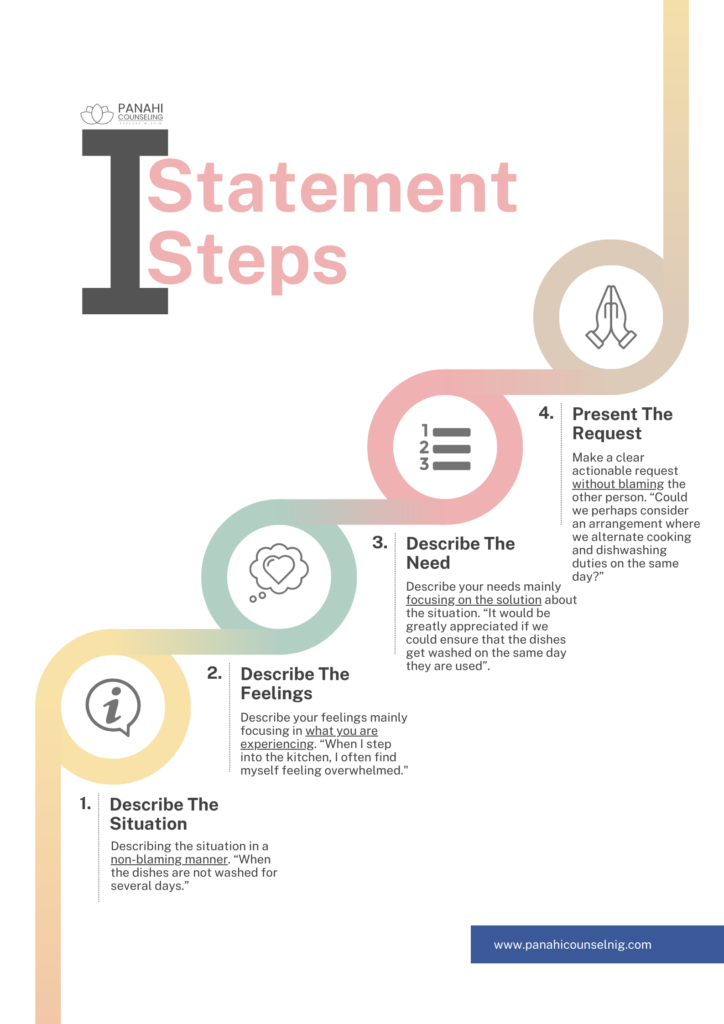"Words have energy and power with the ability to help, to heal, to hinder, to hurt, to harm, to humiliate, and to humble."
Yehuda Berg
Using “I” statements in communication is a powerful tool for fostering a thoughtful and respectful dialogue. When we use “I” statements, we take ownership of our feelings and experiences without casting blame or making assumptions about others. It’s a sincere and empathetic way to express ourselves that honors our reality while leaving space for others to share their perspective.
“I” Statement helps diffuse tension, avoid conflict, and establish an approachable connection. It’s not about being self-centered; it’s about being self-aware and inviting constructive, mutual understanding. When we articulate our thoughts and feelings from our point of view, we create an environment where empathy is possible and real listening can occur and our boundaries are respected.
Switching "YOU" to "I" Can Reduce Defensiveness
Switching from “you” to “I” phrases changes the entire dynamic of a conversation. When we say “you,” it can come across as accusatory or judgmental, which might put others in a defensive posture. In contrast, “I” statements focus on our personal experiences and feelings, which nobody can refute because they are ours alone.
For instance, consider the difference between saying, “You’re not listening to me,” and “I feel unheard.” The former can make the listener feel accused and lead to defensiveness. In contrast, the latter expresses a personal feeling, encouraging empathy rather than confrontation.
Similarly, exchanging “You always interrupt” with “I would like to finish my thoughts before we move on” shifts from blame towards a personal request, fostering understanding and patience. By using “I” statements, we’re not just expressing ourselves but also giving others the space to be heard and respond with their genuine thoughts and feelings.
It’s about nurturing a dialogue where both sides can be open, which is crucial for healthy communication.
The Four-Part "I" Message Formula
Using the “I” Statement formula is simple but needs some practice to come up on the spot. The four-part communication requires observation of the situation, expressing your feelings, asking what you need, and making an explicit request.
The Four-Part Formula
- When (describe the situation)
- I feel (describe your feelings without blaming)
- I need (describe what your needs are)
- I would prefer/like (state your request clearly and respectfully)
Let’s look at each part in the “I” Statement request and ensure that we clearly understand how they build on each other.
- Observation: Begin with a factual observation about the situation, devoid of judgment or evaluation. For instance, “I notice that the room becomes very quiet when I talk about project deadlines.”
- Feelings: Express your feelings about this observation. It’s important to own these feelings as your reaction to the situation. For example, “I feel anxious and concerned when this happens.”
- Needs: Communicate the underlying need that is connected to the feelings you’ve expressed. This can guide the conversation towards potential solutions. You could say, “I need open communication and feedback to ensure we’re on the same page.”
- Request: Make an explicit, actionable request to address your needs. For example, “I would appreciate it if we could have a more interactive discussion during these meetings.”
It’s also essential to use “I” statements calmly and respectfully. If you’re upset or angry, it can be challenging to frame your message positively. Take a deep breath and approach the conversation with a clear head. Remember, you’re not trying to attack the other person; you’re merely expressing how their behavior made you feel.

Practice Makes It Perfect
Like any new habit, it feels more natural over time with repetition and application in real-life scenarios. Consider practicing with a friend or loved one who can provide honest feedback. A therapist can also work with you on this. You can simulate situations that have been communication pain points in the past and explore how “I” statements might alter the outcome.
Embracing “I” statements in our daily interactions is more than just a communication technique—it’s a commitment to building safer and empathetic relationships. By mindfully expressing ourselves and centering our experiences in conversations, we invite a deeper understanding and genuine connection with those around us. This approach doesn’t just ease conflicts; it also nurtures a supportive environment where each voice is valued and heard.
Also, consider reading our article on How to Fight Fairly, providing helpful tips on healthy communication.
Share Post:
Start your therapy journey today.
Schedule a 15-Minute Free Consultation With Our Intake Coordinator.




